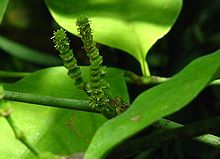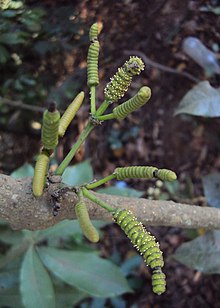Grace
| Grace | ||||||||||||
|---|---|---|---|---|---|---|---|---|---|---|---|---|

Gnetum gnemon , leaves and immature seeds |
||||||||||||
| Systematics | ||||||||||||
|
||||||||||||
| Scientific name of the family | ||||||||||||
| Gnetaceae | ||||||||||||
| Lindl. | ||||||||||||
| Scientific name of the genus | ||||||||||||
| Grace | ||||||||||||
| L. |
Gnetum is the only genus ofthe Gnetaceae family within the order Gnetales . The approximately 30 species are tropical, woody naked-seed plants .
description

Vegetative characteristics
All Gnetum species are woody plants, most are lianas , some are small trees or shrubs . The secondary wood contains trachea . Gnetum have true deciduous leaves , like the leaves of angiosperms . They have broad leaf blades with reticulate veins.
Generative characteristics
The Gnetum species are separate-sex plants, there are monoecious ( monoecious ) or dioecious ( dioecious ) species. The flowers of one sex are in several racemose inflorescences . The nucellus of the ovule is surrounded by three sheaths. The seeds contain two cotyledons ( cotyledons ).




Systematics and distribution
The genus Gnetum was established by Carl von Linné in 1767 . Synonyms for Gnetum L. are Gnemon Rumph. ex Kuntze nom. illeg., Thoa Aubl., Abutua Lour., Arthostema Neck.
The genus Gnetum has a purely tropical distribution, with species in the Neotropics , in West Africa , India and Southeast Asia to Fiji .
The genus Gnetum is divided into two sections and four subsections. There are 30 to 40 types; molecular genetic pedigrees already include most of these species:
- Section Gnetum : It contains three subsections:
- Subsection Gnetum : The two tree species are common in Southeast Asia:
-
Gnetum gnemon
L .: It is cultivated and used in many ways (English: Spanish Joint Fir; Spanish: Malinjo, Melinjo); occurs in at least two varieties:
- Gnetum gnemon L. var. Gnemon (Syn .: Gnetum gnemon var. Ovalifolium (Poir.) Blume ): It is distributed in Tibet , the Malay Archipelago , the Philippines , New Guinea and the islands in the western Pacific to Fiji .
- Gnetum gnemon var. Brunonianum (handle.) Markgr. : It occurs from Assam to western Borneo .
- Gnetum gnemon var. Gracile Markgr. : This endemic occurs only in Sulawesi .
- Gnetum gnemon var. Griffithii (Parl.) Markgr. : It occurs from Assam to the Malay Peninsula.
- Gnetum gnemon var. Tenerum Markgr. : It occurs in Thailand , Malaysia and Borneo .
-
Gnetum gnemon
L .: It is cultivated and used in many ways (English: Spanish Joint Fir; Spanish: Malinjo, Melinjo); occurs in at least two varieties:
- Subsection Micrognemones : The two liana species are common in tropical West Africa:
- Gnetum africanum Welw. : It is common in tropical Central Africa to Angola .
- Gnetum buchholzianum Engl .: It is from Nigeria to tropical West and Central Africa.
- Subsection Araeognemones : The nine or so liana species are common in the Neotropic (Spanish: Ituá):
- Gnetum camporum (margr.) DWStev. & Zanoni : It thrives in the Gran Sabana at altitudes of 1350 to 1500 meters, which is a plateau in Venezuela. The distribution area extends from southern Colombia to southern Venezuela and Guyana .
- Gnetum leyboldii Tul. : It thrives at altitudes of 0 to 500 meters in northern Brazil , from the Amazon to Bolivar in Venezuela, in eastern Ecuador and Colombia . It is also found in Costa Rica , Panama , Bolivia, and Peru .
- Gnetum nodiflorum Brongn. (Syn .: Gnetum amazonicum Tul. ): It thrives in large parts of tropical South America from the lowlands to the Guiana highlands, preferably near rivers.
- Gnetum paniculatum Spruce ex Benth. : It thrives in the lowlands in much of northern South America.
- Gnetum schwackeanum Taub. ex A. Schenk : It occurs from Colombia and Venezuela to northern Brazil .
- Gnetum urens (Aubl.) Blume : It thrives in large parts of the northern lowlands of South America, preferably near rivers.
- Gnetum venosum Spruce ex Benth. : It occurs from Venezuela to northern Brazil.
- Subsection Gnetum : The two tree species are common in Southeast Asia:
- Section Cylindrostachys : There is only one subsection:
- Subsection Cylindrostachys : The approximately 20 liana species are distributed in southern Asia and in the Indomalayic region:
- Gnetum arboreum Foxw. : This endemic occurs only on the Philippine island of Luzon .
- Gnetum catasphaericum H.Shao : It occurs in the Chinese provinces of Yunnan and southern Guangxi .
- Gnetum contractum Markgr. : The home is southern India .
- Gnetum costatum K.Schum. : It occurs from eastern New Guinea to the Solomon Islands .
- Gnetum cuspidatum Blume : Its range extends from Indochina to New Guinea.
- Gnetum diminutum Markgr. : The home is Borneo .
- Gnetum edule (Willd.) Blume (Syn .: Gnetum ula Brongn. ): It occurs in southwestern India. The number of chromosomes is 2n = 22.
- Gnetum giganteum H.Shao : It occurs only in the Chinese Autonomous Region of Guangxi .
- Gnetum gnemonoides Brongn. : Their distribution area extends from Malesia to the Bismarck Archipelago .
- Gnetum gracilipes C.Y.Cheng : The homeland are the Chinese provinces of Yunnan and Guangxi.
- Gnetum hainanense C.Y.Cheng ex LKFu, YFYu & MGGilbert : It occurs from southern China to Hainan .
- Gnetum klossii Merr. ex Markgr. : The home is northern Borneo .
-
Gnetum latifolium Parl . : It occurs in six varieties from Assam to Papuaia.
- Gnetum latifolium var. Funiculare Markgr. : It occurs from Thailand to western Malesia .
- Gnetum latifolium var. Latifolium : It occurs from Assam to New Guinea.
- Gnetum latifolium var. Laxifrutescens (Elmer) Markgr. : It occurs from the Philippines to the Bismarck Archipelago .
- Gnetum latifolium var. Longipes (Margraviate) THNguyên : It occurs in Indochina, the Philippines and New Guinea.
- Gnetum latifolium var. Macropodum (short) Markgr. : It occurs on the Andaman and Nicobar Islands .
- Gnetum latifolium var. Minus (Foxw.) Markgr. : It occurs from Indochina to central Malesia.
-
Gnetum leptostachyum flower : It occurs in four varieties in Indochina and Borneo:
- Gnetum leptostachyum var. Abbreviatum Markgr. : It occurs in Borneo.
- Gnetum leptostachyum var. Elongatum Markgr. : It occurs in Indochina.
- Gnetum leptostachyum var. Leptostachyum : It occurs in northern Thailand and Borneo.
- Gnetum leptostachyum var. Robustum Markgr. : It occurs in Borneo.
- Gnetum loerzingii Markgr. : The home is northern Sumatra .
- Gnetum luofuense C.Y.Cheng : The homeland is southeastern China.
- Gnetum macrostachyum Hook. f. : It occurs from Indochina to western Malesia and New Guinea.
- Gnetum microcarpum flower : It occurs from southern Indochina to western Malesia.
- Gnetum montanum Markgr. : It occurs from the Himalayas to southern China and Indochina. The number of chromosomes is 2n = 44.
- Gnetum neglectum Blume : The home is Borneo.
- Gnetum oblongum Markgr. : It occurs from Bangladesh to Myanmar .
- Gnetum oxycarpum Ridl. : The home is Sumatra.
- Gnetum parvifolium (Warb.) Cheng : It occurs from southern China to Indochina.
- Gnetum pendulum C.Y.Cheng : It occurs from Tibet to southern China.
- Gnetum raya Markgr. : The home is Borneo.
- Gnetum ridleyi Gamble : The home is Malaysia.
- Gnetum tenuifolium Ridl. : It occurs from Thailand to Sumatra.
- Subsection Cylindrostachys : The approximately 20 liana species are distributed in southern Asia and in the Indomalayic region:
Without assignment to a section:
- Gnetum interruptum Biye : It was first described in 2013 from west-central tropical Africa.
- Gnetum latispicum Biye : It was first described in 2013 and occurs from Cameroon to the Central African Republic.
use
Plant parts are eaten from many species of Gnetum . The starchy seeds are roasted or they are ground; Flatbreads are baked from the flour in fat. The leaves are prepared as leafy vegetables . Some species are used as medicinal plants. The bark provides high quality fibers, for example for string instruments.
swell
- Christopher J. Earle: Gnetum Linnaeus 1753. In: The Gymnosperm Database. March 1, 2019, accessed April 6, 2019 .
- H. Won, SS Renner: The internal transcribed spacer of nuclear ribosomal DNA in the gymnosperm Gnetum. In: Molecular Phylogenetics and Evolution , Volume 36, 2005, pp. 581-597. doi : 10.1016 / j.ympev.2005.03.011
- H. Won, SS Renner: Dating dispersal and radiation in the gymnosperm Gnetum (Gnetales) - clock calibration when outgroup relationships are uncertain. In: Systematic Biology , Volume 55, Issue 4, 2006, pp. 610-622. Full text online doi : 10.1080 / 10635150600812619
- Maarten JM Christenhusz, James L. Reveal, Aljos Farjon, Martin F. Gardner, Robert R. Mill, Mark W. Chase: A new classification and linear sequence of extant gymnosperms. In: Phytotaxa , Volume 19, 2011, pp. 55-70. Full text PDF.
Individual evidence
- ↑ a b c d e f g Christopher J. Earle: Gnetum Linnaeus 1753. In: The Gymnosperm Database. March 1, 2019, accessed April 6, 2019 .
- ↑ a b c d e f g h i j k l m n o p q r s t u v w x y z aa ab ac ad ae af ag ah ai aj ak al am an ao ap aq ar as at au av aw ax ay Rafaël Govaerts (ed.): Gnetum. In: World Checklist of Selected Plant Families (WCSP) - The Board of Trustees of the Royal Botanic Gardens, Kew . Retrieved May 6, 2019.
- ↑ a b Gnetum at Tropicos.org. In: IPCN Chromosome Reports . Missouri Botanical Garden, St. Louis
Web links
- Grace . In: U. Brunken, M. Schmidt, S. Dressler, T. Janssen, A. Thiombiano, G. Zizka: West African plants - A Photo Guide. Senckenberg Research Institute, Frankfurt am Main 2008.
- Gnetum at Tropicos.org. In: Flora Mesoamericana . Missouri Botanical Garden, St. Louis
further reading
- Chen Hou, Aelys M. Humphreys, Olle Thureborn, Catarina Rydin: New insights into the evolutionary history of Gnetum (Gnetales). In: Taxon , Volume 64, Issue 2, 2015, pp. 239-253. doi : 10.12705 / 642.12
- Chen Hou: Evolutionary studies of the Gnetales. Thesis for PhD degree, Stockholm June 2016. online.

